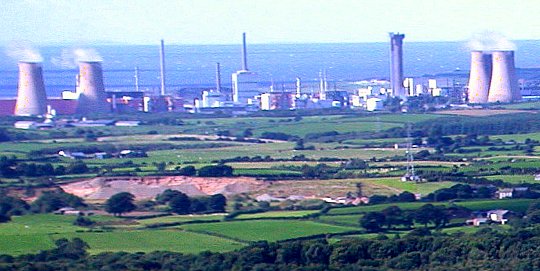
Sellafield, AD 2001

But if too much Wigner damage is allowed to accumulate in the graphite, the heat energy released by the graphite as its' atoms relax to their preferred positions can cause a thermal runaway reaction, increasing the temperature of the graphite to over 200 Celsius and igniting it, as happened in the tragic reactor fire at the Calder Hall atomic power station near Windscale (now called Sellafield) in 1957. To release the Wigner energy, the temperature of the core was increased but there were in-sufficient temperature gauges to monitor the temperature, and part of the graphite moderator must have been significantly higher whilst the temperature guage in another part measured but 200C. Part of the graphite moderator slipped into thermal runaway, releasing more Wigner energy and further increasing the temperature. A canister containing lithium and magnesium, put in the reactor to generate tritium for a British H-bomb, was probably the first to burst and ignite. At these high temperatures the fuel rods which ran through the graphite core ruptured and temperatures soared to 1300 Celsius. Considerable quantities of the volatile and highly dangerous radioactive isotopes iodine-131, strontium-89, strontium-90 and caesium-137, all fission by-products, were released. These radioactive by-products went straight up the chimney stack, through the filters atop the stack which were supposed to stop such accidental releases, and into the atmosphere. This is called nuclear fallout. There used to be two such stacks with filters. The tall wide chimney to the right of centre in the photograph is the one remaining stack, its' filter has been removed. At first carbon dioxide was pumped in in an effort to smother the flames from burning graphite, but this was just converted to oxygen and fed the flames still higher. Water was eventually used to put out the fire and moderate the neutrons, as most of the graphite moderators had burnt into carbon dioxide, but the use of water was hazardous, it could have reacted with hot reactor parts producing hydrogen, oxygen and acetylene to cause a massive explosion. Luckily, it didn't. Afterwards, the reactor was unsalvageable. As many of the fuel rods as possible were removed, leaving 6700 damaged elements still within, then the lot was buried in concrete. It still gives off heat by radioactive decay today. Its sister reactor next door, Windscale number 2, was shut down shortly afterwards, being considered un-safe for continued use. The reactors, AGR's or Advanced Gas-cooled Reactors, are air-cooled, and the graphite moderator readily burns in air if allowed to get too hot! Not so advanced after all!
The fire resulted in the contamination of land (and of cows milk) for miles around, particularly by the radioactive caesium-137 which can substitute for calcium. At the time of the accident two other dangerously radioactive isotopes were being secretely manufactured - polonium-210 for atomic bomb triggers, and plutonium-239 for nuclear bomb material; these were also also emitted. The release of these last two radionuclides possibly constituted the worst radiological contamination of the countryside in the World. This information was suppressed for decades. Years later, in 1986, the Chernobyl nuclear reactor in Kiev was to get much of the blame for the land contamination when it too set on fire, but the cause and effect were different. There is a higher incidence of death from leukemia, cancer of the blood, in an area downwind of Sellafield at the time of the accident: Copeland and South Lakeland.
The fire in the core continued for 24 hours. During this time the wind blew the fallout south-easterly over England and Europe. On-site workers were exposed to radiation levels 150 times above the prescribed dose limit, which is set higher for workers in the nuclear industry than the general population anyway. Some members of the local population were exposed to radiation doses 10 times higher than their maximum lifetime dose allowances. The day after, the milk from surrounding farms contained more than 50,000 bequerals per litre, where the maximum allowed is 3700 Bq. Rather alarmingly, this was knowingly allowed to be distributed rather than cause alarm to the population! Milk from the area was only banned 3 days later! Only 25 years later was any of this secrecy made public! To avoid unwelcome adverse associations, and after another major leak (of radioactive ruthenium), the name Windscale was changed to Sellafield in 1976 by the UKAEA. Leaks of radioactive waste, un-accounted losses of plutonium and other cover-ups of both deliberate and accidental discharges of radioactivity both into the air and into the sea continue with alarming regularity. Perhaps another name change is in order?
It is thought that the fire led to the release of between 600 and 1000 Tera bequerals of iodine-131, 444-596 TBq of tellurium-132, 45.5 TBq of caesium-137 and 0.2 TBq of strontium-90, plus an estimated 1369 TBq of polonium-210. The NRPB have since calculated that the fire has caused 32 deaths and 260 extra cancers in the population, but independant experts put the total death toll at more than 1000 lives.
![]()
![]()